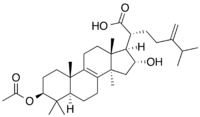Pachymic acid
 | |
| Names | |
|---|---|
| IUPAC name
3-Acetoxy-16-hydroxy-24-methylenelanost-8-en-21-oic acid | |
| Systematic IUPAC name
(2R)-2-[(3S,5R,10S,13R,14R,16R,17R)-3-acetyloxy-16-hydroxy-4,4,10,13,14-pentamethyl-2,3,5,6,7,11,12,15,16,17-decahydro-1H-cyclopenta[a]phenanthren-17-yl]-6-methyl-5-methylideneheptanoic acid | |
| Identifiers | |
| 3D model (JSmol) |
|
| ChemSpider | |
| KEGG | |
| PubChem CID |
|
| |
| |
| Properties | |
| C33H52O5 | |
| Molar mass | 528.76 g/mol |
| Density | 1.1±0.1 g/cm3 |
| Boiling point | 612.2±55.0 °C at 760 mmHg |
| Hazards | |
| Flash point | 184.7±25.0 °C |
| Except where otherwise noted, data are given for materials in their standard state (at 25 °C [77 °F], 100 kPa). | |
| | |
| Infobox references | |
Pachymic acid is a natural triterpenoid chemical that can be extracted from the root of various Pinus species, where it is produced by parasitic fungus Wolfiporia extensa (synonym Wolfiporia cocos). The dried sclerotia of the fungus is used as a traditional Chinese medicine, and pachymic acid is one of the major bioactive components of it.[1]
Effects
Pachymic acid is known to inhibit the Epstein-Barr virus and to inhibit the snake venom phospholipase A2.[2] It also has antitumor and anti-inflammatory properties.[1]
References
- 1 2 Shu, Shaohua; Chen, Bei; Zhou, Mengchun; Zhao, Xinmei; Xia, Haiyang; Wang, Mo (2013). "De Novo Sequencing and Transcriptome Analysis of Wolfiporia cocos to Reveal Genes Related to Biosynthesis of Triterpenoids". PLOS ONE. 8 (8): e71350. PMC 3743799
 . PMID 23967197. doi:10.1371/journal.pone.0071350.
. PMID 23967197. doi:10.1371/journal.pone.0071350. - ↑ "Pachymic acid Biological Test Results". PubChem compound database. 3 March 2016.
This article is issued from
Wikipedia.
The text is licensed under Creative Commons - Attribution - Sharealike.
Additional terms may apply for the media files.